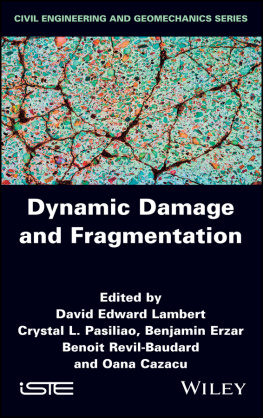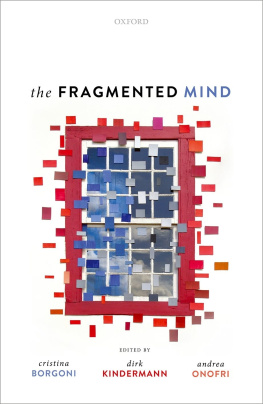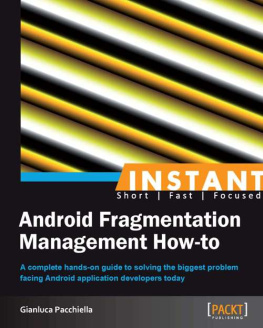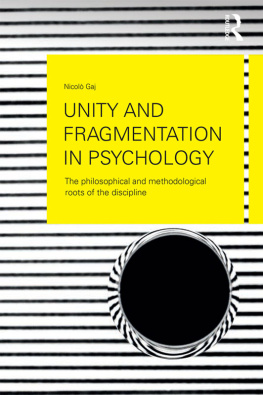Cazacu Oana - Dynamic Damage and Fragmentation
Here you can read online Cazacu Oana - Dynamic Damage and Fragmentation full text of the book (entire story) in english for free. Download pdf and epub, get meaning, cover and reviews about this ebook. City: London;UK, year: 2019, publisher: John Wiley & Sons, Incorporated;ISTE Ltd, genre: Home and family. Description of the work, (preface) as well as reviews are available. Best literature library LitArk.com created for fans of good reading and offers a wide selection of genres:
Romance novel
Science fiction
Adventure
Detective
Science
History
Home and family
Prose
Art
Politics
Computer
Non-fiction
Religion
Business
Children
Humor
Choose a favorite category and find really read worthwhile books. Enjoy immersion in the world of imagination, feel the emotions of the characters or learn something new for yourself, make an fascinating discovery.
- Book:Dynamic Damage and Fragmentation
- Author:
- Publisher:John Wiley & Sons, Incorporated;ISTE Ltd
- Genre:
- Year:2019
- City:London;UK
- Rating:3 / 5
- Favourites:Add to favourites
- Your mark:
- 60
- 1
- 2
- 3
- 4
- 5
Dynamic Damage and Fragmentation: summary, description and annotation
We offer to read an annotation, description, summary or preface (depends on what the author of the book "Dynamic Damage and Fragmentation" wrote himself). If you haven't found the necessary information about the book — write in the comments, we will try to find it.
Dynamic Damage and Fragmentation — read online for free the complete book (whole text) full work
Below is the text of the book, divided by pages. System saving the place of the last page read, allows you to conveniently read the book "Dynamic Damage and Fragmentation" online for free, without having to search again every time where you left off. Put a bookmark, and you can go to the page where you finished reading at any time.
Font size:
Interval:
Bookmark:

Series Editor
Flix Darve
Edited by
David Edward Lambert
Crystal L. Pasiliao
Benjamin Erzar
Benoit Revil-Baudard
Oana Cazacu

First published 2019 in Great Britain and the United States by ISTE Ltd and John Wiley & Sons, Inc.
Apart from any fair dealing for the purposes of research or private study, or criticism or review, as permitted under the Copyright, Designs and Patents Act 1988, this publication may only be reproduced, stored or transmitted, in any form or by any means, with the prior permission in writing of the publishers, or in the case of reprographic reproduction in accordance with the terms and licenses issued by the CLA. Enquiries concerning reproduction outside these terms should be sent to the publishers at the undermentioned address:
ISTE Ltd
27-37 St Georges Road
London SW19 4EU
UK
www.iste.co.uk
John Wiley & Sons, Inc.
111 River Street
Hoboken, NJ 07030
USA
www.wiley.com
ISTE Ltd 2019
The rights of David Edward Lambert, Crystal Pasiliao, Benjamin Erzar, Benoit Revil-Baudard and Oana Cazacu to be identified as the authors of this work have been asserted by them in accordance with the Copyright, Designs and Patents Act 1988.
Library of Congress Control Number: 2018959945
British Library Cataloguing-in-Publication Data
A CIP record for this book is available from the British Library
ISBN 978-1-78630-408-7
The engineering applications of the Air Force Research Laboratory exercise a diverse spectrum of extreme and dynamic loading conditions that challenges the state-of-the art capability of engineering tools. Munitions applications include the extreme conditions of operational employment as well as the safety protocols designed for protection from accidents and adversarial threats. The operational scenario begins with delivery platforms that can make the systems subject to long-duration ~0 (hrs), high-temperature vibrations and the combination thereof. The engagement phase can induce high-pressure (10s of kbar) mid-duration ~0 (ms) with a combined shear component. The terminal phase of detonation and fragmentation accentuates all of these loadings with ~0 (ns) detonation shock loading reaching Mbar peak pressures all under triaxial stress conditions at strain rates of nearly 0 (106 cm/s/s). The detonation process occurs on the timescale of nanoseconds, with giga watts of power being released in sub-millimeter length scales for shock- and blast-driven work. This seemingly rudimentary, stochastic event has had more than 100 years of research by the broader community, yet significant gaps remain in our understanding.
Furthermore, these systems are built to survive a suite of six hazards mandated via the insensitive munitions (IM) requirements. The IM hazards represent accidents and intentional threats a munition might encounter throughout its life cycle. Each of these also drives the need for constitutive models, including advanced mathematical frameworks for damage, fracture and fragmentation as well as complementary numerical frameworks, and furthermore, necessary experiments and diagnostics of such.
This book presents recent advances that have been made in the understanding, experimental characterization, theoretical models and numerical simulations of the aforementioned thermo-mechanical processes. It is based on selected invited lectures and lively exchanges of ideas at the 10th US-French symposium Dynamic damage and fragmentation, Fort Walton Beach, Fl, 1719 May 2017 organized under the auspices of the International Center for Applied Computational Mechanics (ICACM) at the University of Florida/REEF.
The first part of this book presents an overview of the numerical approaches developed for modeling instabilities leading to plastic flow localization and failure in isotropic metallic materials. For moderate loadings, models for description of strain localization induced by local softening either due to local heating and plastic dissipation (see , which is devoted to the characterization and modeling of the plastic behavior of refractory metals, it is shown that only by considering the combined influence of anisotropy and strength differential effects on the mechanical response, the particularities of the mechanical response of these materials under extreme environments can be captured with accuracy.
Advancement in understanding and modeling the mechanical behavior can be achieved only through integration with experiments. Recent progress made in the development of methodologies to measure the local strain fields and their direct exploitation to calibrate model parameters using inverse methods are presented in . Specifically, it is shown that laser-driven shocks can be used to investigate the mechanical response over a range of very high strain rates (~107 s1), high loading pressures, small spatial scales and very short durations of pressure application (~ns). Moreover, their relatively low destructiveness facilitates easier sample recovery and easier instrumentation than the more conventional shock loading techniques based on explosives or plate impacts.
The second part of this book presents an overview of the experimental methods and numerical approaches developed for modeling the overall mechanical behavior and instabilities in brittle materials, including cementitious and ceramic materials and granular media. Such materials are very heterogeneous, and contain a large number of defects such as micro-voids or micro-cracks that strongly influence their quasi-static and dynamic behavior. is devoted to modeling of the influence of the crack density and orientation on three-dimensional wave propagation.
The need to numerically model the limit stage when matter no longer sustain the imparted strains and more or less progressively transits from continuum to a discrete state has led to the development of discrete element methods (DEM). is devoted to modeling instabilities in this framework.
New experimental capabilities developed in the past decade for studying the high-rate behavior of concrete and ceramics are presented in .
Finally, another facet of this book is that a variety of materials are presented. As an example, presents an alternative approach to modeling the high-rate regime of behavior using a hypo-elastic modeling approach.
It is a privilege of the Editors to thank all the contributors for their enthusiastic collaboration. Oana Cazacu and Benoit Revil-Baudard gratefully acknowledge the financial support provided by the Office of the Vice-President for Research at the University of Florida, the Doolittle Institute, Niceville, USA, and CEA Gramat, France, for the 10th US-French symposium that enabled the writing of this book.
David Edward LAMBERT, Crystal L. PASILIAO, Benjamin ERZAR,
Benoit REVIL-BAUDARD and Oana CAZACU
October 2018
Some Issues Related to the Modeling of Dynamic Shear Localization-assisted Failure
Engineering design of structures to withstand accidental events involving high strain rates and/or impact loading requires predictive modeling capabilities for reproducing numerically potential premature failure following adiabatic shear banding (ASB). The purpose of the present chapter is to review ASB-oriented modeling approaches available in the literature (while not pretending to be exhaustive) that provide a better understanding of ASB and its consequences in structural metals and alloys.
Next pageFont size:
Interval:
Bookmark:
Similar books «Dynamic Damage and Fragmentation»
Look at similar books to Dynamic Damage and Fragmentation. We have selected literature similar in name and meaning in the hope of providing readers with more options to find new, interesting, not yet read works.
Discussion, reviews of the book Dynamic Damage and Fragmentation and just readers' own opinions. Leave your comments, write what you think about the work, its meaning or the main characters. Specify what exactly you liked and what you didn't like, and why you think so.








